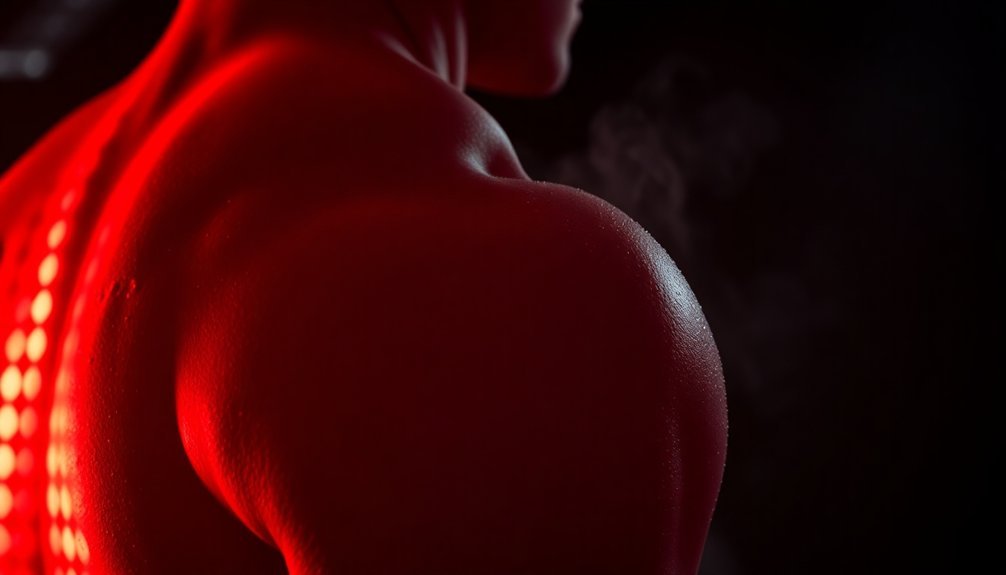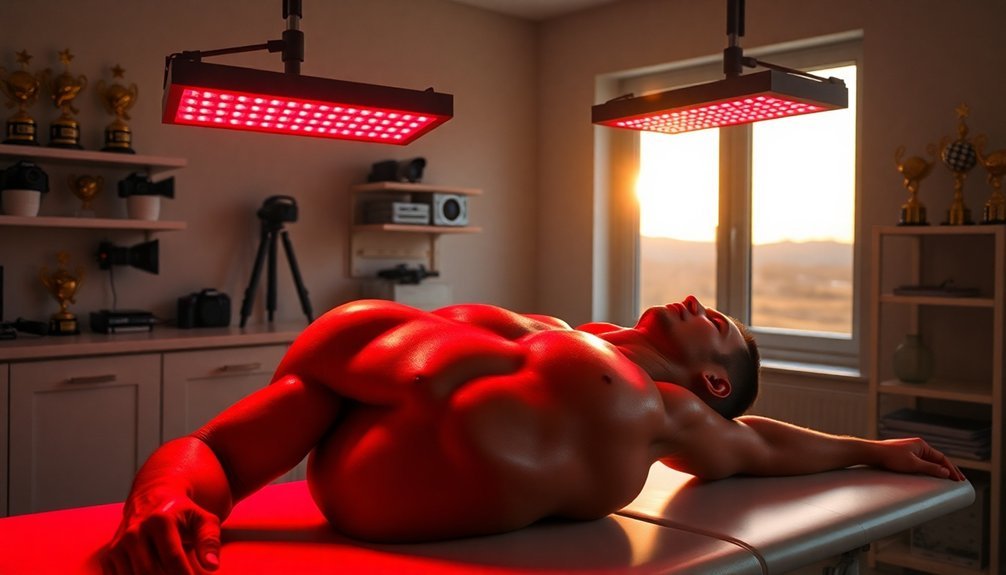You can accelerate muscle growth with photobiomodulation therapy (PBM), which uses red and near-infrared light to stimulate your muscles at the cellular level. This cutting-edge treatment boosts your body's ATP production, enhances protein synthesis, and speeds up recovery between workouts. By applying PBM for 5-20 minutes before or after training, you'll experience reduced muscle soreness, increased strength gains, and faster muscle development. Elite athletes already use this technology to maximize their results, with studies showing improved muscle performance and reduced recovery time. Discover how this powerful therapy can transform your muscle-building journey.
What Is Photobiomodulation Therapy

Light therapy has emerged as a groundbreaking muscle-building tool called Photobiomodulation (PBM) therapy, also known as Low-Level Laser Therapy. Using red and near-infrared light, PBM targets your muscles and tissues to enhance healing, reduce pain, and boost performance.
The therapy works by stimulating your cells' mitochondria, increasing ATP production, and triggering positive cellular changes that support muscle growth and recovery. Cytochrome c oxidase plays a crucial role in absorbing the therapeutic light energy.
When you undergo PBM therapy, the light penetrates your tissue at specific wavelengths between 655 and 950 nm. You'll receive controlled doses of light energy, typically ranging from 20 to 300 joules, delivered through lasers, LEDs, or broadband light devices.
The power density varies from 0.005W/Cm² to 5 W/Cm², with lower densities promoting healing and higher densities providing pain relief.
You'll find PBM particularly useful for muscle building because it enhances cellular metabolism, reduces inflammation, and accelerates tissue repair. The therapy's non-invasive nature means you won't experience adverse effects, and it's compatible with various training programs.
Whether you're recovering from a workout or trying to maximize muscle gains, PBM can support your fitness goals by optimizing cellular function and promoting tissue regeneration.
Science Behind Muscle Growth
The complex process of muscle growth relies on a delicate balance between protein synthesis and breakdown in your body. When you exercise, particularly through resistance training, you trigger multiple cellular mechanisms that stimulate muscle growth. Your muscles respond to this stress by activating satellite cells, which multiply and fuse with muscle fibers to create new muscle tissue. Research shows that using 70% of maximum load during resistance training is most efficient for stimulating muscle growth.
| Growth Factor | Primary Function | Impact on Muscles |
|---|---|---|
| IGF-I & II | Protein synthesis | Regulates mass growth |
| Testosterone | Amino acid uptake | Enhances cell repair |
| Insulin | Glucose transport | Supports cell growth |
| FGF | Revascularization | Aids regeneration |
You'll need to understand that muscle growth isn't instant – it's a gradual process that takes weeks or months to become visible. When you lift weights, you're activating specific pathways that lead to protein synthesis, but there's a critical threshold you must reach. Following Henneman's Principle, you'll want to use progressive resistance with weights ranging from 30-80% of your maximum capacity to effectively recruit muscle fibers and optimize growth. This scientific approach, combined with consistent training and proper recovery, creates the foundation for sustainable muscle development.
Benefits For Athletic Performance

Building up to peak athletic performance requires more than just traditional training methods. Red light therapy can give you a significant competitive edge by enhancing your body's natural performance capabilities.
You'll experience improved muscle endurance as photobiomodulation increases your ATP production and delays fatigue onset. Studies show that oxygen uptake increases during aerobic training with pre-exercise light therapy. Your muscles will work harder and longer, especially when you apply the therapy before your workout sessions.
You'll also develop greater power and strength through faster recovery and enhanced muscle fiber adaptation.
The therapy's impact on recovery is particularly remarkable. You'll bounce back faster from intense training sessions as red light therapy reduces inflammation and repairs microscopic muscle tears.
This faster recovery means you can maintain a more consistent training schedule while minimizing downtime between sessions.
For overall athletic performance, you'll benefit from the combined effects of improved endurance, enhanced strength, and accelerated recovery. The therapy's ability to stimulate mitochondria and boost cellular energy levels directly translates to better performance outcomes.
With scientific evidence supporting these benefits, red light therapy proves to be a valuable tool for optimizing your athletic potential.
Optimal Treatment Protocols
To maximize these athletic performance benefits, understanding proper treatment protocols is key. You'll want to focus on both timing and treatment parameters for the best results.
Research shows you can apply photobiomodulation either before exercise to enhance performance or after exercise to speed up recovery.
For ideal results, you'll need to target multiple sites on your muscles using specific energy doses ranging from 0.375 J to 41.7 J per site. Treatment times typically run between 30 seconds to 5 minutes, with power densities of 0.05 W/cm² for red light and 0.15 W/cm² for infrared light.
You can use either single laser probes, LED clusters, or flexible LED arrays that emit wavelengths of 660 nm (red) or 850-905 nm (infrared).
While both single and multiple sessions are effective, you'll see more lasting results with regular treatments over several weeks. Whether you choose a portable device like GameDay™ or a stationary unit, make sure it's properly calibrated and covers your target muscle areas completely.
For larger muscles like your quadriceps, you may need to treat multiple points to guarantee full coverage.
Real Athletes Share Success Stories

You'll find compelling evidence of PBM's effectiveness in Olympic and professional athletes who've reported faster recovery times between intense training sessions.
Top competitors have shared how PBM therapy helped them gain muscle mass while maintaining peak performance during critical competition periods.
Professional sports teams are now incorporating PBM treatments into their standard recovery protocols, with athletes consistently reporting reduced muscle soreness and improved training results.
Elite Athletes' Recovery Times
Through rigorous training and competition, elite athletes have discovered that recovery times vary substantially across different sports and training intensities.
Sprint performance recovery ranges from 24 to 96 hours, with soccer players needing more than 72 hours, while basketball players bounce back in 48-72 hours.
Creatine Kinase (CK) levels, a key marker of muscle damage, take even longer to normalize, requiring 72 hours or more to return to baseline. This is especially true in high-intensity sports like rugby and soccer, where the extended duration and intensity of play markedly impact recovery needs.
You'll see the best results by combining multiple recovery strategies. Cold water immersion (CWI) and compression garments have proven particularly effective for maintaining performance in high-intensity sports.
Moreover, photobiomodulation (PBM) has emerged as a game-changing recovery tool. When you use PBM before exercise, you'll experience enhanced performance and reduced fatigue. It works by increasing ATP production in your muscles and decreasing inflammation, while also improving your maximum voluntary contraction and oxygen consumption capabilities.
Training Results From Olympians
Consistently impressive results emerge from Olympic athletes who've incorporated photobiomodulation (PBM) into their training regimens. You'll find that these elite athletes report significant gains in muscle mass and faster recovery times when using PBM devices before and after their workouts.
Whether they're using single laser probes, LED clusters, or flexible arrays, the results show clear improvements in performance metrics.
The science behind their success is compelling. When you apply PBM before exercise, you'll experience enhanced muscle performance and reduced inflammation, regardless of the wavelengths used. Athletes report they're able to complete more repetitions with greater torque, while muscle biopsies show decreased oxidative stress and inflammation markers.
You'll benefit most by following Olympic athletes' proven application methods. They're using PBM for both preconditioning and post-exercise recovery, maximizing ATP production and cell proliferation. The treatment increases cytochrome c-oxidase in your skeletal muscle fibers, leading to better mitochondrial function and energy production.
CrossFit athletes have also documented impressive results when combining PBM with static magnetic fields, demonstrating enhanced recovery and overall physical performance improvements.
Pro Teams Adopt PBM
Professional athletes across major sports leagues have embraced PBM therapy as a cornerstone of their training and recovery protocols. You'll find NFL players using PBM regularly to maintain peak performance and speed up recovery between grueling games. NBA and MMA athletes have also adopted this technology, recognizing its powerful benefits for muscle regeneration and performance enhancement.
CrossFit athletes are combining PBM with static magnetic fields to boost their recovery and athletic performance. What's particularly interesting is how these athletes are timing their treatments – some use it before workouts to prime their muscles and prevent damage, while others apply it post-exercise to accelerate recovery.
You'll typically see them spending 5-20 minutes per session under PBM devices.
The results speak for themselves. Athletes report significant improvements in muscle mass gains, reduced inflammation, and enhanced energy production during training. The science backs up their experiences, with clinical trials showing that PBM increases ATP production and decreases oxidative stress.
Whether you're looking to train harder, recover faster, or build more muscle, you're following a path that's been validated by the world's top athletes and sports teams.
Getting Started With PBM
Starting your journey with photobiomodulation (PBM) requires understanding the basic parameters and equipment options available. You'll need to choose between single laser probes, LED clusters, or flexible LED arrays that emit red and near-infrared light wavelengths. Each device type offers specific benefits for muscle growth and recovery.
You can apply PBM either before or after your workouts for the best results. Pre-exercise application helps precondition your muscles, while post-workout treatment aids recovery and reduces inflammation.
When selecting your device, focus on those that deliver red and near-infrared wavelengths, as these have shown the most promising results in clinical studies.
To maximize benefits, you'll want to target specific muscle groups immediately before or after training. The treatment stimulates your mitochondrial function, increases ATP production, and promotes satellite cell activation – all essential factors for muscle growth.
Start with the manufacturer's recommended settings and treatment times, as proper dosing is vital for effectiveness. Remember that PBM works by enhancing your body's natural recovery processes, so consistency in application is key to achieving better muscle growth and recovery outcomes.
Frequently Asked Questions
Can Photobiomodulation Be Combined With Steroids or Other Muscle-Building Supplements?
While you can physically combine them, there's no research proving it's safe to use photobiomodulation with steroids or supplements. It's best to stick with PBM alone since it naturally enhances muscle performance.
Does Skin Color or Body Fat Percentage Affect PBM Treatment Effectiveness?
Neither your skin color nor body fat substantially impacts PBM treatment effectiveness. You'll still get the therapeutic benefits, as PBM works primarily by boosting cellular ATP production, regardless of these physical characteristics.
Are There Any Age Restrictions for Using Photobiomodulation Therapy?
You can safely use photobiomodulation therapy at any age, but you'll need to follow standard safety protocols. While some clinical trials have specific age limits, there aren't general age restrictions for PBM treatments.
Will PBM Treatments Interfere With Existing Medical Conditions or Medications?
Yes, PBM can interact with certain medications and conditions. You'll need to be cautious if you're taking photosensitizing drugs or immunosuppressants. Always consult your healthcare provider before starting PBM therapy.
How Long Do Muscle-Building Results From PBM Therapy Typically Last?
You'll see immediate effects lasting hours to days, but long-term muscle gains require consistent PBM therapy. With regular treatments and exercise, you can maintain your results for months, though you'll need ongoing sessions.
In Summary
You've discovered an exciting frontier in muscle enhancement through photobiomodulation therapy. Whether you're a competitive athlete or dedicated gym-goer, PBM offers a science-backed way to boost your gains. By following proper protocols and working with qualified providers, you'll tap into light therapy's natural muscle-building potential. Start your PBM journey today to accelerate recovery, increase strength, and achieve the muscular results you're after.





Leave a Reply